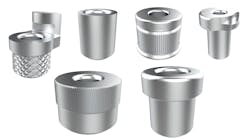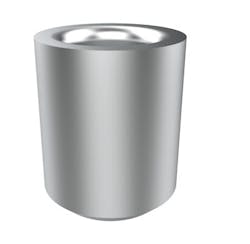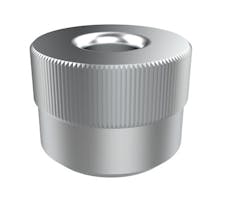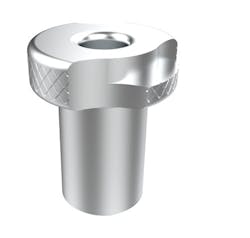Drill Bushings Make for Better, More Accurate Holes
Drill bushing are mainly used as guides for cutting tools, but they are also used in fixtures for assembly and inspection tools, as well as other applications require precise alignment and location of cylindrical parts.
One common application for drill bushings is to support twist drills, which are efficient at making holes but difficult to center. As a result, it is notoriously inaccurate at creating holes in an exact location. Drilled holes are often off-center, oversized, out of round, out of alignment and not straight. However, supporting the twist drill with a drill bushing greatly reduces, if not eliminates, most of these problems.
Drill bushings are identified by an alphanumeric code that describe the bushing’s form and size in a format established by the American National Standards Institute (ANSI). This format consists of one to four letters identifying the bushing type, followed by its OD (in 1/64-in. increments), length (in 1/16-in. increments), and the bushing’s ID stated to four decimal positions.
There are three general categories of drill bushings: permanent bushings, renewable bushings and air-feed-drill bushings.
Permanent Drill Bushings
Permanent bushings are used in limited-production applications where bushings are not regularly changed during the life of the workholder. They are pressed into the fixture or cast in place. These bushings are permanently installed because replacing them would put wear on the mounting hole and reduce the accuracy and soundness of the installation. The following are different varieties of permanent bushings.
Press-fit bushings (type P or PC if the bushing is carbide) are the most common and least expensive and are identified by the code They are used in one-step operations such as drilling or reaming. The bushings are pressed directly into the fixture and held in place by the force of the press fit. The headless design lets bushings be mounted close together and flush with the top of the jig plate. This design, however, offers little resistance to heavy axial loads.
Head-press-fit bushings (type H or HC) are like press-fit bushings but have a head. They are used for applications in which heavy axial loads might push a press-fit bushing through the mounting hole. They bushings can be installed with head exposed or counterbored if the bushing must be flush with the top of the fixture. When counterbored, only the busing body’s diameter needs to be reamed to locate the hole. The counterbored area provides clearance for the head and should not be a precision fit. The length of the bushing is measured from the underside of the head to the bottom of the bushing.
Serrated press-fit bushings (type SP) are for applications in which a hardened drill bushing is mounted in a soft jig plate. The bushings’ mounting surface has a precision-ground diameter and a serrated or straight-knurled area. The ground portion aligns the bushing in the mounting hole. The serrations prevent high torque loads from causing the bushing to rotate. The serrations also resist axial loads that could push the bushing through the jig plate. These bushings are well suited for fixtures made from aluminum, magnesium, Masonite, wood and similar soft materials.
Serrated-groove bushings (type SG) are serrated over their entire length. The serrations and grooves cut around the bushing’s circumference lets them be used in pressed-in or cast-in-place applications. These bushings offer high torque resistance, but their straight-knurled mounting surfaces reduces their resistance to axial loads. Similarly, the circumference of these bushings is serrated and not ground, so the internal diameter must be used to align the bushing for cast-in-place applications.
Diamond-groove bushings (type DG) are for cast-in-place applications and not press-fit applications. They resemble serrated-groove bushings, but have a diamond knurl rather than straight knurl on the circumference. The diamond knurl better resists rotational and axial forces. Like the serrated-groove bushings, the circumference of diamond-groove bushings is knurled and not ground, so the internal diameter must be used to align the bushings. These bushings are installed in holes with diameters larger than that of the bushing. The space between the bushing and the inside of the hole gets filled with an epoxy resin or a low melting-point alloy.
Template bushings (type TB) are designed for thin jig plates. They let larger diameter tools be used with thin jig plates. Rather than using a thicker jig plate normally required to support larger diameter drills, template bushings provide the necessary drill support in jig plates from 1/16 to 3/8-in. thick. This reduces the jig plate’s cost and weight. Once properly located, the mounting hole is drilled and reamed .001 to .003 in. larger than the bushing’s mounting diameter. The hole is countersunk on the workpiece side letting the bushing seat 0.015 in. below the surface.
The bushing is inserted and pressed into this hole. The installation tool also adds the retaining ring. When mounting the retaining ring, the top of it should be within +.005 in./−.10 in. of the top of the groove in the bushing before using the installation tool. Serrations on the bushing circumference prevent rotational movement. The retaining ring locks the bushing in the jig plate and restricts axial movement.
Renewable Drill Bushings
Renewable bushings are designed to be changed when they wear out or when several operations are performed in the same hole. When it takes several machining operations to create the proper hole, two or more drill bushings are used: renewable drill bushings and liner bushings. The drill bushing locates and supports the cutting tool while the liner bushing locates and supports the drill bushing. Drill bushings and liner bushings are available in several styles:
Slip/Fixed renewable bushings (types SF and SFC) are the most commonly used renewable bushings. This bushing replaces older and obsolete slip renewable bushings, including types S and F bushings. They combine slip and fixed locking arrangements in the same bushing, and are typically used for long production runs where bushing changes are needed.
These bushings can be installed in fixed-renewable or slip-renewable configurations by simply rotating the bushing. The fixed-renewable installation is for single-step applications such as drilling or reaming. The bushings are only changed only when they wear out. Fixed-renewable bushings are held in place with a lock screw or round clamp. The clamps hold the bushing in place and prevent movement during machining. When the bushing must be replaced, the clamp is removed and the bushing changed. The clamp is then reinstalled to securely hold the bushing.
Slip-renewable installations are convenient for applications when several are performed in the same hole. One example is drilling and reaming the same hole. The first slip-renewable bushing is installed, the hole is drilled and the bushing removed. Then a reaming bushing is installed, and the hole reamed to size.
The slip-renewable side allows rapid changeover. Turning the bushing clockwise locks it in place and turning it counterclockwise unlocks it for removal. A cutout at the end of the recess makes the bushing easy to remove and replace. This design ensures the drill’s rotation of the drill will not let the bushing back out of the hole. Although slip/fixed renewable bushings are normally installed in a liner bushing, they can also be installed directly in the jig plate.
Liner bushings (type L) resemble press-fit versions but are larger. These bushings are used with renewable-style bushings to provide a hardened, wear-resistant hole in an otherwise-soft jig plate. The close sliding fit between the renewable bushing and liner bushing lets the bushing be changed repeatedly over long production runs with no loss of positional accuracy. The liner bushings lack a head so they can be mounted close together and flush with the top of the jig plate. As with the press-fit bushing, however, these bushings offer less resistance to heavy axial loads.
Head Liner bushings (type HL) are like liner bushings in design and application, but they are made with a head. Head-liner bushings, like head-press-fit bushings, are designed for applications where heavy axial loads might push a press-fit bushing through the mounting hole. These bushings can be mounted with the head exposed or counterbored, as shown. When the jig plate is counterbored for mounting, only the body diameter of the bushing provides the location and only this diameter needs to be reamed. The counter-bored area provides clearance for the head and should not be a precision fit.
Josh Herschbach and Nancy Shepard are engineers at Carr Lane Manufacturing.






